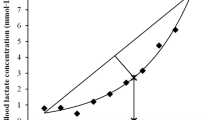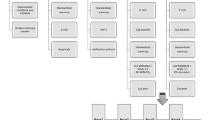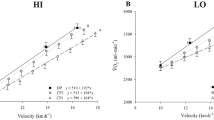Summary
To determine why black distance runners currently out-perform white distance runners in South Africa, we measured maximum oxygen consumption (V O 2max), maximum workload during a V O 2max test (L max), ventilation threshold (V Thr), running economy, inspiratory ventilation (V I), tidal volume (V T), breathing frequency (f) and respiratory exchange ratio (RER) in sub-elite black and white runners matched for best standard 42.2 km marathon times. During maximal treadmill testing, the black runners achieved a significantly lower (P<0.05) L max (17 km h−1, 2% grade, vs 17 km h−1, 4% grade) and V I max (6.21 vs 6.821 kg−2/3 min−1), which was the result of a lower V T (101 vs 119 ml kg−2/3 breath−1) as f max was the same in both groups. The lower V T in the black runners was probably due to their smaller body size. The V Thr occurred at a higher percentage V O 2max in black than in white runners (82.7%, SD 7.7% vs 75.6%, SD 6.2% respectively) but there were no differences in the V O 2max. However, during a 42.2-km marathon run on a treadmill, the black athletes ran at the higher percentage V O 2max (76%, SD 7.9% vs 68%, SD 5.3%), RER (0.96, SD 0.07 vs 0.91, SD 0.04) and f (56 breaths min−1, SD 11 vs 47 breaths min−1, SD 10), and at lower V T (78 ml kg−2/3 breath−1, SD 15 vs 85 ml kg−2/3 breath−1, SD 19). The combination of higher f and lower V T resulted in an identical V I. Blood lactate levels were lower in black than in white runners (1.3 mmol l−1, SD 0.6 vs 1.59 mmol l−1, SD 0.2 respectively). It appeared that the only physiological difference that may account for the superior performance of the black runners was their ability to run at a higher percentage V O 2max max during competition than white runners.
Similar content being viewed by others
References
Adams WC, Fox RH, Fry AJ, MacDonald IC (1975) Thermoregulation during marathon running in cool moderate, and hot environments. J Appl Physiol Respir Environ Exerc Physiol 38:1030–1037
Armstrong RB (1979) Biochemistry: energy liberation and use. In: Strauss RH (ed) Sports medicine and physiology. Saunders, Philadelphia, pp 3–29
Astrand PO, Rodahl K (1977) Textbook of work physiology. McGraw-Hill, New York
Bergmeyer HU (ed) (1981) Methods of enzymatic analysis, vol 1, 2nd edn. Verlag Chemie, Florida, pp 1464–1468
Cerny FJ, Holmes J, Sills R (1982) Exercise breathing pattern in black and white school children and young adults (abstract). Med Sci Sports Exerc 14:131
Consolazio CF, Johnson RE, Pecora LJ (1963) Physiological measurement of metabolic functions in man. McGraw-Hill, New York
Costill DL, Fox EL (1969) Energetics of marathon running. Med Sci Sports Exerc 1:81–86
Costill DL, Winrow E (1970) Maximal oxygen intake among marathon runners. Arch Phys Med Rehabil 51:317–320
Costill DL, Branam G, Eddy D, Sparks K (1971) Determinants of marathon running success. Int Z Angew Physiol Einschl Arbeitsphysiol 29:249–254
Dawson B, Pyke F (1984) The effects of heat stress on anaerobic threshold. Aust J Sci Med Sport 16:3–9
Jokl E, Thomas C (1964) Physiology of exercise. Thomas, Springfield, Ill.
Lusk G (1928) The sciences of nutrition. Saunders, Philadelphia
Maron MB, Wagner JA, Horvath SM (1977) Thermoregulatory responses during competitive marathon running. J Appl Physiol Respir Environ Exerc Physiol 42:909–914
McArdle WD, Katch FI, Katch VL (1981) Exercise physiology: energy, nutrition and human performance. Lea and Febiger, Philadelphia
Noakes TD, Adams BA, Greeff C, Lotz T, Nathan M (1988) The danger of an inadequate water intake during prolonged exercise. A novel concept revisited. Eur J Appl Physiol 57:210–219
Phillips JC (1976) Toward an explanation of racial variation in top-level sports participation. Int Rev Sport Sociol 3:39–53
Pollock ML, Gettman LR, Jackson A, Ayres J, Ward A, Linnerud AC (1977) Body composition of elite class distance runners. Ann NY Acad Sci 381:361–370
Rhodes EC, McKenzie DC (1984) Predicting marathon time from anaerobic threshold measurements. Phys Sportsmed 12:95–98
Sherman WM (1983) Carbohydrates, muscle glycogen and muscle glycogen supercompensation. In: Williams M (ed) Ergogenic aids in sport. Human Kinetics, Champaign, Ill, pp 3–29
Siri WE (1956) Gross composition of the body. In: Lawrence JH, Tobias CA (eds) Advances in biological and medical physics. Academic Press, New York, pp 239–280
Weiner JS, Lourie JA (1981) Practical human biology. Academic Press, London
Author information
Authors and Affiliations
Rights and permissions
About this article
Cite this article
Bosch, A.N., Goslin, B.R., Noakes, T.D. et al. Physiological differences between black and white runners during a treadmill marathon. Eur J Appl Physiol 61, 68–72 (1990). https://doi.org/10.1007/BF00236696
Accepted:
Issue Date:
DOI: https://doi.org/10.1007/BF00236696




